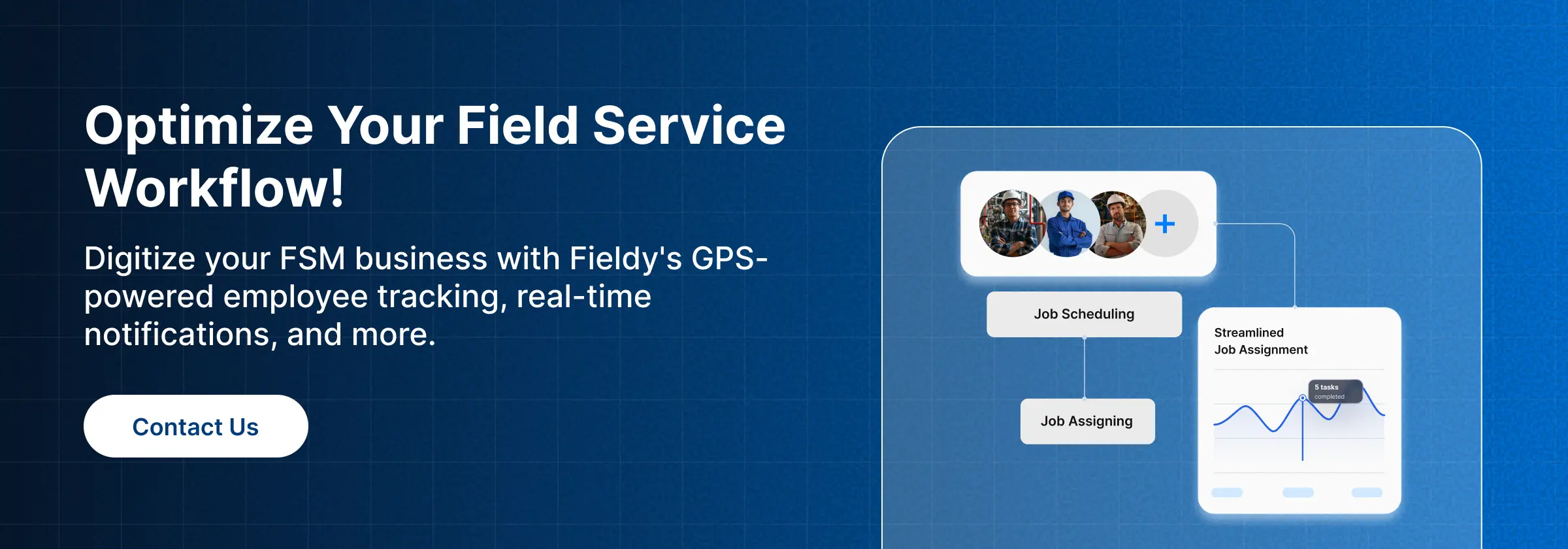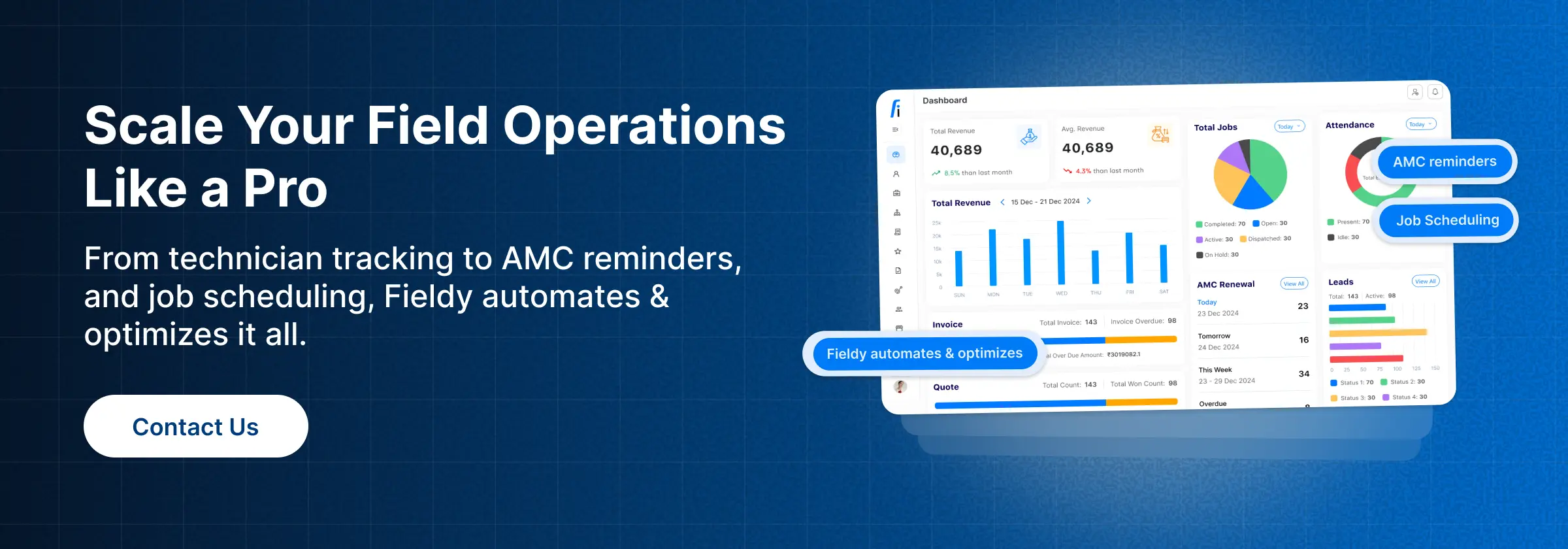👋 Introduction
As the mobile workforce, from HVAC technicians to IT support, directly impacts customer experience and the business’s bottom line, their productivity determines whether a field service company grows or fails. As the workforce represents the company to the customers and drives revenues and operational costs, its productivity is crucial.
Still, many field service managers have these unresolved concerns:
- How can employee productivity be enhanced without increasing the workload?
- How can employee productivity be measured accurately?
- Does employee monitoring improve productivity, or does it erode trust?
As of 2025, the challenge is overcome through harmonious integration of technology, measurement, and organisational culture. The use of advanced tools such as GPS tracking, real-time updates, and AI-driven scheduling not only improves efficiency but also helps employees.
Tools like Fieldy are changing how productivity is monitored and enhanced. With the integration of live visibility, smart dispatch, and mobile-first workflows, companies are witnessing tangible improvements in productivity as well as employee satisfaction. Fieldy’s employee productivity tracking software shows how businesses can implement these features to track efficiency and empower teams.
🚀 Why Productivity Monitoring Matters in Field Service?
In contrast to office-based jobs, field service is devoid of any form of visibility. Technicians are always on the move and are also subjected to other unpredictable challenges such as being late due to traffic, being late due to having a job with no complete details, and on the spot being delayed due to other unexpected issues. Without any form of tracking, managers practically have no clue about the performance.
Field Service Management Report (FSM), 2024 by Gartner: A real time tracking system for productivity adopted by companies led to an increase of 27% in the first-time fix and about 19% reduction in the missed SLAs within a year.
Key reasons why monitoring matters:
- Eliminate inefficiencies such as unnecessary travel and idle technicians.
- Refine resource allocation in order to meet demands without excess staff.
- Enhance client satisfaction by minimising wait times and delivering dependable service.
- Improve employee satisfaction by acknowledging top performers and easing workflow.
What employee monitoring entails is better explained by the absence of surveillance. When conducted transparently, it removes barriers for employees and provides managers with insights to assist their teams.
📊 Key KPIs to Measure & Track Productivity in Field Service
To know how to track employee productivity effectively, you need the right Key Performance Indicators (KPIs). These metrics ensure you’re not just measuring activity but true performance outcomes.
⚙️ Operational Efficiency Metrics
- First-Time Fix Rate (FTFR): Percentage of jobs resolved in the first visit. Higher FTFR = less rework, more efficiency.
- Average Job Completion Time: How long it takes to resolve tasks, including travel.
- Jobs Completed Per Day: Tracks workload efficiency across individuals and teams.
Example: A plumbing business discovered that by reassigning jobs based on technician expertise, their FTFR rose from 68% to 85%, saving over 200 service hours per quarter.
🤝 Customer-Centric Metrics
- Response Time (“Time to Site”): Measures how quickly technicians reach customers after a service request. Faster response times not only improve customer trust but also strengthen SLA compliance, which directly impacts retention rates.
- Job Volume per Technician: Tracks the number of jobs handled by each technician per day or week. It helps balance workload distribution, preventing burnout while ensuring optimal resource utilization. Companies can use this metric to identify high performers and provide support where needed.
- Customer Satisfaction (CSAT/NPS): Captures direct feedback from clients about their service experience. A higher CSAT or Net Promoter Score reflects not just efficiency but also the quality of interaction, professionalism, and issue resolution—factors that heavily influence repeat business and referrals.
Industry Statistic: A Microsoft field service study found that 85% of customers value fast response times more than price when choosing service providers.
👷 Workforce Management Metrics
- Time Utilization vs Idle Time: Are employees working on revenue-generating activities or waiting for assignments?
- Overall Labor Effectiveness (OLE): A composite score of availability × performance × quality.
- Technician Utilization Rate: Percentage of scheduled hours actively spent on jobs.
Tracking these KPIs gives you a 360° view of performance, covering speed, quality, customer outcomes, and employee engagement.
🛠️ How to Improve Employee Productivity in Field Service?
So, how do you go beyond tracking and actually increase employee productivity in 2025? The answer lies in leveraging both technology and culture.
1. 📍Leverage Mobile & GPS Tools
- GPS tracking ensures smarter routing and reduced downtime.
- Mobile dashboards keep technicians updated on job changes instantly.
Example: A telecom service provider used GPS-enabled routing and cut technician travel by 22% annually, saving both time and fuel costs.
2. 🤖Automate Scheduling & Optimized Routing
- AI-powered field service scheduling software assigns jobs based on skill, location, and availability.
- Optimized routing means more jobs per day with less stress on technicians.
3. 📱 Use a Field App for Instant Updates
- Field service management mobile apps replace paper-based work orders.
- Mobile logging ensures jobs are tracked in real-time and compliance is met.
4. 🧑🏫 Provide Real-Time Support & Training
- Mobile-guided workflows help technicians troubleshoot faster.
- Continuous training through microlearning modules boosts skill sets.
5. 💬 Encourage Feedback & Team Engagement
- Regular feedback loops give technicians a voice.
- Recognition programs drive accountability and motivation.
Pro Tip: Improving productivity is not about making employees work harder, it’s about helping them work smarter and more efficiently.
📈 How Fieldy Helps You Measure & Improve Productivity
Fieldy offers a powerful set of tools designed specifically to track, measure, and improve employee productivity in field service businesses:
- 🛰️ GPS & Real-Time Updates: An Employee GPS Tracking App provides live visibility into technician movement, travel times, and job status, helping managers accurately track employee productivity.
- 🧭 Team Management & Smart Dispatch: Field team management software assigns jobs intelligently based on technician skills, location, and workload, which helps increase employee productivity without overburdening staff.
- 🔎 Real-Time Technician Tracking: A Field Staff Tracking App enables managers to measure employee productivity by monitoring job progress, completion rates, and time spent on-site.
- ⚡ Field Service App: A mobile-first design with offline capability, digital job logging, and instant updates that empower technicians while giving managers the ability to improve employee productivity seamlessly.
These features directly support critical KPIs like First-Time Fix Rate (FTFR), jobs per day, response times, and customer satisfaction scores, making it easier for field service companies to make data-driven decisions.
Industry Insight: Businesses using FSM platforms like Fieldy report 25–30% higher technician productivity compared to companies relying on manual processes.
🏆 Best Practices for Productivity Tracking
To maximize outcomes, adopt these best practices when learning how to measure employee productivity:
-
🎯 Set Clear KPIs Aligned with Roles & Goals
- Define metrics like First-Time Fix Rate (FTFR), jobs completed per day, average response time.
- Tailor KPIs to roles (technicians vs. dispatchers) for fair, goal-driven tracking.
-
⚡ Automate Data Capture with FSM Software
- Replace error-prone spreadsheets with Field Service Management (FSM) software.
- Use tools like GPS tracking, mobile job logs, and real-time updates for accurate, effortless reporting.
-
📅 Review Dashboards Regularly
- Analyze weekly or monthly dashboards to spot bottlenecks (e.g., long travel times, recurring delays).
- Use insights to optimize routes, scheduling, or workload distribution
-
🙌 Provide Feedback & Recognition
- Use tracking insights for constructive coaching rather than criticism.
- Recognize high performers with shoutouts, bonuses, or growth opportunities to boost morale.
-
📚 Invest in Training & Knowledge Sharing
- Identify skill gaps through productivity data (e.g., low FTFR may indicate need for training).
- Offer microlearning, mentorship, or updated manuals to support continuous improvement.
-
🤝 Build a Culture of Trust Around Monitoring
- Be transparent: explain why KPIs are tracked and how they help both company and employees.
- Show that monitoring reduces workload, improves efficiency, and creates growth opportunities
When employees understand that tracking is used for growth, recognition, and support, not punishment, engagement and productivity naturally increase.
🔄 Quick Recap: With vs. Without Fieldy’s Productivity Tools
| 🚫 Without Fieldy | 🚀 With Fieldy |
|---|---|
| 👀 Limited visibility into field operations | 📍 Real-time GPS tracking |
| ⏳ Inefficient dispatching | 🧭 Smart routing & AI scheduling |
| ⚠️ Reactive decision-making | 📊 Proactive, data-driven management |
| 📝 Heavy paperwork | 📱 Mobile-first, automated workflows |
| 📉 Lower productivity, missed SLAs | ✅ Higher FTFR, more jobs per day, better customer satisfaction |
🔮 Future of Employee Productivity in Field Service (2025 & Beyond)
The next wave of productivity isn’t just about tracking, it’s about predictive and proactive enablement.
- AI Copilots: Provide real-time troubleshooting support to technicians.
- Predictive Workforce Management: Anticipate demand spikes, absenteeism, and resource needs.
- Wearables & AR: Hands-free assistance, remote expert guidance, and safer operations.
- Employee Well-being: Companies are realizing sustainable productivity requires focusing on mental health and balanced workloads.
Industry Insight: Deloitte predicts that by 2027, 40% of field service organizations will adopt AR/VR tools to assist technicians, further boosting first-time fix rates.
📝 Conclusion
Learning how to improve employee productivity in field service is no longer optional; it’s a survival strategy. With the right KPIs, tracking tools, and employee support systems, businesses can ensure consistent growth, happier customers, and motivated teams.
Tools like Fieldy give managers the visibility and control they need, while empowering employees to perform at their best. Monitoring productivity isn’t about surveillance; it’s about building a smarter, more efficient, and more supportive workplace.
Final Call-to-Action: Ready to transform how you measure and manage your mobile workforce? Explore how Fieldy’s Employee Productivity Tracking can help you achieve operational excellence in 2025.
❓ FAQs
What are the best metrics to measure employee productivity in field service?
A: The key metrics are First-Time Fix Rate (FTFR), jobs completed per day, average response times, technician utilization rate, and customer satisfaction scores. Together, these KPIs provide a balanced view of both operational efficiency and service quality, ensuring productivity is measured fairly and accurately.
How to increase employee productivity without overburdening staff?
A: Focus on smarter scheduling, mobile tools, and training rather than adding more workload. Efficiency, not just effort, drives results.
How to measure employee productivity accurately?
A: Accurate measurement requires combining operational KPIs (like job completion rates) with customer-focused metrics (like satisfaction scores). Using FSM software that automates data capture and analysis eliminates manual errors and gives managers a clear, real-time view of productivity levels across teams.
How to track employee productivity in real time?
A: GPS tracking, smart dispatch, and mobile job updates enable live visibility into technician progress and performance.
Does employee monitoring increase productivity?
A: Yes, when done transparently and ethically. Monitoring helps spot inefficiencies, track progress, and provide employees with better tools and support. Rather than micromanaging, it creates accountability and boosts morale, leading to higher overall productivity.




